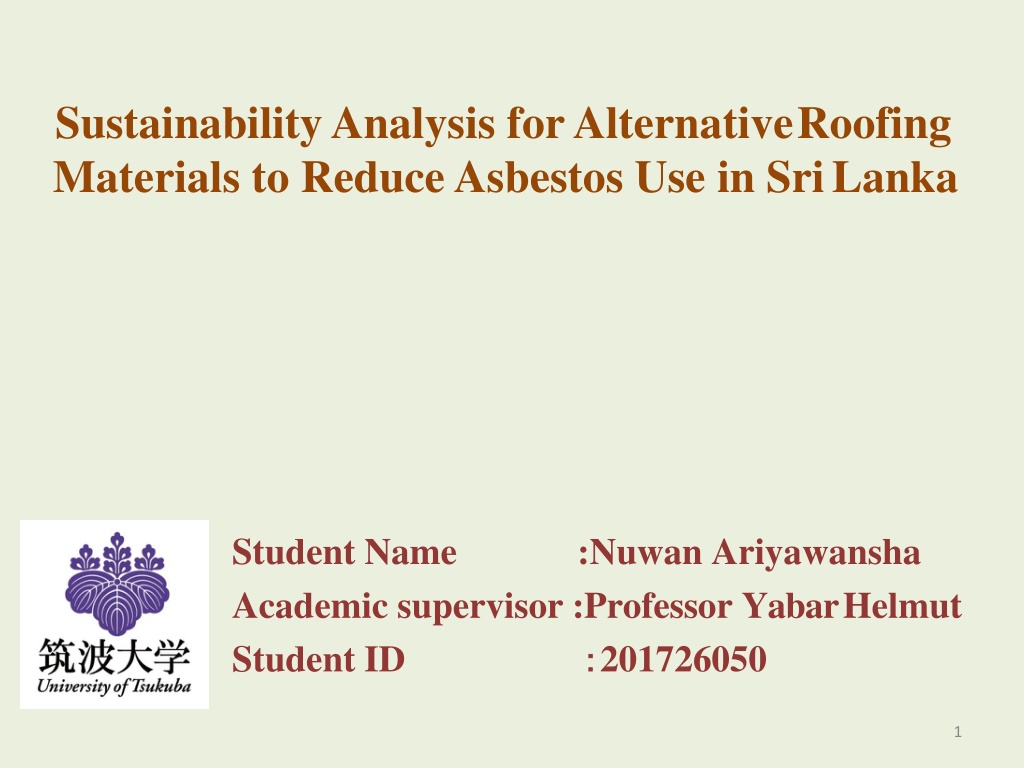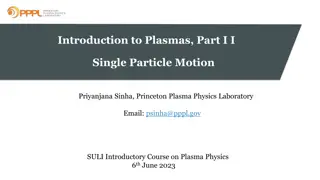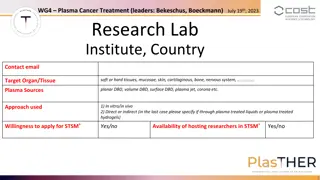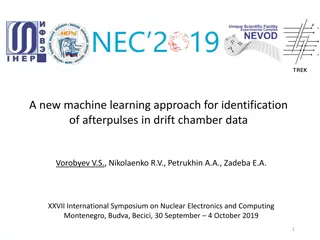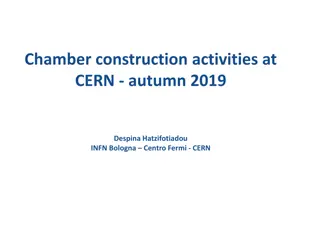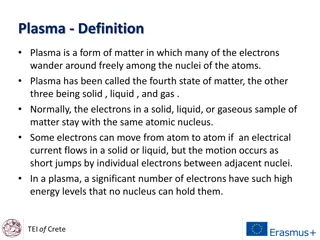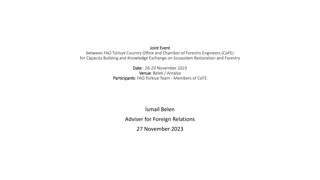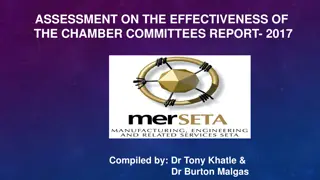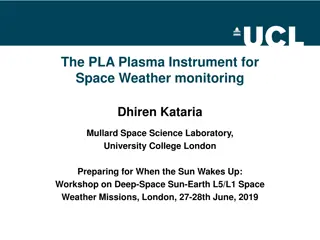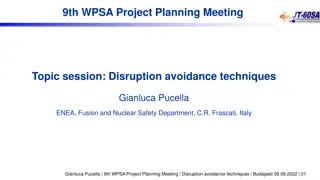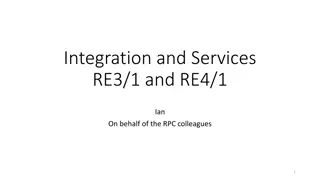Active Plasma Chamber: Status and Perspectives
Motivations for designing an active plasma chamber focusing on reducing plasma losses and enhancing charge state distribution. Details about the general features of the chamber, including its construction and segmentation. The inner active chamber made of aluminum elements for improved efficiency. Benefits such as real-time monitoring of plasma losses and enhanced operation with lower pressure and RF power. Future perspectives and progress updates discussed at the PANDORA progress meeting.
Download Presentation

Please find below an Image/Link to download the presentation.
The content on the website is provided AS IS for your information and personal use only. It may not be sold, licensed, or shared on other websites without obtaining consent from the author.If you encounter any issues during the download, it is possible that the publisher has removed the file from their server.
You are allowed to download the files provided on this website for personal or commercial use, subject to the condition that they are used lawfully. All files are the property of their respective owners.
The content on the website is provided AS IS for your information and personal use only. It may not be sold, licensed, or shared on other websites without obtaining consent from the author.
E N D
Presentation Transcript
Sustainability Analysis for AlternativeRoofing Materials to Reduce Asbestos Use in SriLanka Student Name Academic supervisor :Professor YabarHelmut Student ID 201726050 :Nuwan Ariyawansha 1
Outline of Presentation Background of Research Research Question Objectives of the Research 1 2 3 Data Collection Study Area Methodology 4 5 6 7 Results 8 Discussion 9 FutureWork
1 Background of Research According to the World Health Organization; All types of asbestos cause lung cancers. For example Asbestosis and Mesothelioma are the most commoncancers. Source:-http://www.who.int/ipcs/assessment/public_health/asbestos/en/-cited 2018/2/6 3
1 Background of Research 1.1 Asbestos banned nations around theworld According to the International Ban Asbestos Secretariat; Asbestos is banned in 55 countries worldwide. However, it has not been banned in China, Russia, India, Canada and theUnited States. Asbestos banned nations 4 Source http://www.asbestosnation.org/facts/asbestos-bans-around-the-world/-cited 2018/02/06
1 Background of Research 1.2 Asbestos limiting policy decisions in SriLanka 1987 Blue Asbestos (Crocidolite)banned Government decided to limit theWhite Asbestos( Chrysotile) and promote substitutes from 2018-01-01 2016 Government changed the above decision and emphasis more study to limit the WhiteAsbestos. 2017 Source :-http://www.cabinetoffice.gov.lk/ 5
1 Background of Research 1.3 Principal roofing materials distribution of occupied housingunits 2001 2012 1%2% 2% 0.20% 8% 0.90%10.30% 4.10% 14% 47.50% 2% 55% 35.10% 18% Tile Asbestos Tile Concrete MetalSheet Other Asbestos Zink Aluminium Sheet Cadjan/palmyrahStraw Concrete Metalsheet Cadjan/Palmyrah/Straw Other Not reported Source -Department of Census and Statistics 2001 and 2012
1 Background of Research 1.4 Variation of Asbestos and ZincAluminum import to Sri Lanka 70000 y = 2085.2x -4E+06 60000 50000 Import Quantity/(Tons) Asbestos 40000 ZincAluminium 30000 20000 y = 1878.9x -4E+06 10000 0 2000 2002 2004 2006 2008 2010 2012 2014 2016 2018 Y ear 7 Source - Sri Lanka Customs
2 Research Question How can Sri Lankan government implement a long lasting national policy to limit Asbestosin construction industry, while supporting the country s economy, national health, and selecting alternative roofing materials? 8
3 Objectives of the Research To identify clustering pattern of roofing materials use in Sri Lanka. To observe spatial and temporal variation of roofing materials in the country. To propose suitable measures to government to reduce Asbestos and identify alternative materials. 9
4 Data Collection Primary Data Production quantity and Electricity consumption data from three clay tile factories and two Zinc Aluminum factories. Secondary Data Department of Census and Statistics Sri Lanka. Sri Lanka Customs data. Academic Journals, publications, etc.. 10
5 Study Area 322divisions in 25 districts 268 divisions in 18 districts 11
6 Methodology 2001 Statistical Data 2012 Statistical Data Alternative material manufacturingdata Asbestos Clay tile ZincAluminum Asbestos Clay tile Clay tile ZincAluminum Divisional SecretaryDivision Divisional Secretary Division Input the Percentage of roof materials Life Cycle Assessment Optimized hot spot analysis Cold spot-99% Confidence Cold spot-95% Confidence Cold spot-90% Confidence Notsignificant Hot spot-90% Confidence Hot spot-95% Confidence Hot spot-99%Confidence Global Warming Potential (GWP) Acidification Potential (AP) Health Impact Potential (HIP). Spatial and Temporal changes Environmental Effect 12 Suitable mitigation measures to reduce asbestos usage and promote alternatives
7 Results 7.1 Asbestos clustering pattern 2001-2012 13
7 Results 7.2 Clay tile clustering pattern 2001-2012 14
7 Results 7.3 Zinc Aluminum clustering pattern 2012 15
7 Results Hot spots and cold spots of Tile, Asbestos and Zinc Aluminum (% of Administrative divisions to the total) Tile Asbestos Zn/Al 2001 2012 2001 2012 2012 Coldspot-99% Confidence Coldspot-95% Confidence Coldspot90% Confidence 21.27 32.46 19.78 25.75 26.87 10.45 4.85 6.34 4.10 3.73 2.61 1.49 3.73 3.36 1.49 Not significant 42.16 26.49 42.16 30.22 35.45 Hotspot90% Confidence Hotspot95% Confidence Hotspot99% Confidence 1.49 1.49 1.87 2.99 1.12 4.10 2.61 6.34 7.84 1.12 17.91 30.60 19.78 25.75 30.22 Total 100.00 100.00 100.00 100.00 100.00 16
7 Results Summary of Hot spots and cold spots of Tile, Asbestos and Zinc Aluminum (% of Administrative divisions to the total) Material Tile Asbestos Zn/Al Year 2001 2012 2001 2012 2012 Cold spot 34.33 38.81 29.85 33.21 32.09 Not significant 42.16 26.49 42.16 30.22 35.45 Hot spot 23.51 34.70 27.99 36.57 32.46 100.00 100.00 100.00 100.00 100.00 17
8 Discussion Asbestos hot spots are concentrated in developed areas in 2001 (Colombo and Kandy). NewAsbestos hot spots have been forming in the Northern section of the country. Clay tile hot spots are concentrated in Southern and North-Western parts of the country in 2001. A new Clay tile hot spot has been formed in the South-Eastern section, and hot spot in the North-Western section hasexpanded. Zinc Aluminum hot spots are formed in the central part ofthe country in 2012. 18
9 Future Work Identify Socio-economic factors for roofing materials usage based on the Hot spot analysis. Calculation of Global Warming Potential (GWP), Acidification Potential (AP) and Health Impact Potential (HIP). Policy study for reducing asbestos usage. 19
